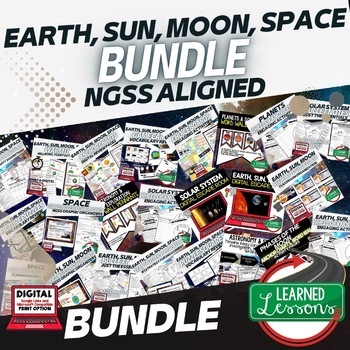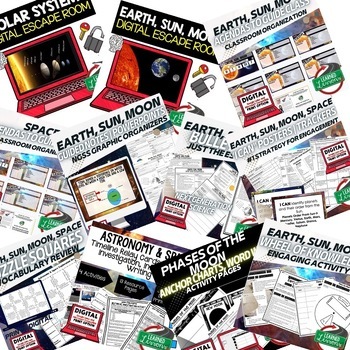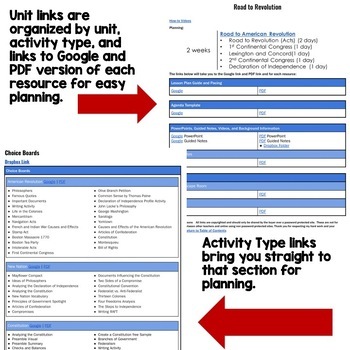Earth, Sun, Moon, Planets BUNDLE (Earth Science BUNDLE) Astronomy Bundle
Learned Lessons LLC
10.6k Followers
Grade Levels
5th - 12th, Homeschool
Subjects
Resource Type
Standards
NGSSMS-ESS1-2
NGSSMS-ESS1-3
NGSSMS-ESS1-1
Formats Included
- Zip
- Google Apps™
Pages
500 pages
Learned Lessons LLC
10.6k Followers

Includes Google Apps™
This bundle contains one or more resources with Google apps (e.g. docs, slides, etc.).
What educators are saying
My students liked this activity because it helped hem to understand he concept in a creative way. It was a great way to get them motivated. It helped all levels of ELLs.
Great resources and activities - need to be modified to use in high school. Perfect for middle school.
Products in this Bundle (26)
showing 1-5 of 26 products
Bonus
Digital Links for Google Classroom & Dropbox Link
Description
Earth Science Astronomy and Space Exploration BUNDLE, Google Classroom, Print & Digital Learning
Click Here for Earth Science MEGA BUNDLE
INCLUDED IN THIS BUNDLE:
- Astronomy & Space Warm Ups & Bell Ringers, NGSS 6-8 Science
- Astronomy and Space Exploration Student and Teacher Guided Notes
- Astronomy and Space Exploration Choice Board Activities (Paper and Digital Version)- 1 Board, 9 Activities, 18 pages
- Astronomy and Space Exploration Timeline Relay and Writing Activities (Paper and Digital Version)
- Astronomy and Space Exploration I Cans
- Astronomy and Space Exploration Puzzles and Vocabulary Matching (12 pages)
- Astronomy and Space Exploration Game Cards, I Have Who Has (47)
- Space Race Biography Cubes and Writing Extension
- Astronomy and Space Exploration Anchor Charts Great as word walls, bulletin boards, and bellringers!
- Astronomy and Space Exploration Word Wall Pennants
- Astronomy and Space Exploration Picture Puzzle
- Planets and Solar System Word Wall and Activity Pages
- Phases of the Moon Anchor Charts, Posters, Word Wall, Activity Pages Google Link
- Earth, Sun, Moon Just the Essentials Content Next Generation Science, Google Link
- Solar System and Technology Just the Essentials Content Next Generation Science, Google Link
- Earth, Sun, Moon Interactive Guided Notes and PowerPoints NGSS Google
- Solar System and Space Exploration Guided Notes and PowerPoints NGSS, Next Generation Science Standards with Google Classroom Link
- Planets Project Activity Wheel of Knowledge
- Solar System Digital Escape Room, Solar System Breakout Room, Test Prep
- Earth, Sun, Moon Activity Wheel of Knowledge, Interactive Notebook
- Solar System Activity Wheel of Knowledge, Interactive Notebook
- Planets Activity Wheel of Knowledge, Interactive Notebook
- Earth, Sun, Moon Digital Escape Room, Breakout Room
- Earth, Sun, Moon Agenda PowerPoint & Google Slides, Earth Science Agenda
- Space Agenda PowerPoint & Google Slides, Earth Science Agenda
- Earth, Sun, Moon Science Reading Comprehension Passages and Questions
- Space, Planets, Solar System Science Reading Comprehension Passages & Questions
Topics Covered:
- Sun
- Earth
- 3rd Planet from Sun
- Rotation
- Spheres
- Moon
- Mercury
- Neptune
- Sun
- Revolution
- Sun’s Gravitational Pull
- The Sun
- Rotation Axis
- Gravitational Pull of Earth
- Lunar Cycle
- Waxing Phase
- Full Moon
- Waning Phases
- New Moon
- Solar Eclipses
- Lunar Eclipses
- Seasons
- Earth’s Tilted Axis
- Tilt of Earth
- 365 days
- Season days
- Summer Solstice
- Winter Solstice
- Equinoxes
- Spring Equinox
- Fall Equinox
- Tides
- High Tide
- Low Tide
- Tidal Range
- Spring Tide
- Neap Tide
- Order of Planets
- Solar System
- Stars
- Hertz Sprung
- Russell Diagram
- Telescopes
- Light Reflection
- Light Refraction
- The Apollo Program
- Space Shuttles
- International Space Station
FOLLOW TO GET UPDATES WHEN NEW RESOURCES ARE ADDED
Links to all MEGA BUNDLES
- Civics and Government MEGA Bundle
- Economics/Free Enterprise MEGA Bundle
- American History MEGA Bundle Colonial US to Reconstruction
- American History MEGA Bundle Western Frontier to President Trump
- World Geography MEGA Bundle
- World History Part 1 MEGA Bundle
- World History Part 2 MEGA Bundle
- English MEGA Bundle
- Physical Science MEGA Bundle
- Life Science MEGA Bundle
- Earth Science MEGA Bundle
Other Resources to Check Out:
- Social Studies MEGA BUNDLES
- Deals $2 and Under
- Social Studies Word Walls
- Social Studies Anchor Charts
- Social Studies Picture Puzzles
- Social Studies Games
- Social Studies Cut and Paste
- Social Studies DBQs and Speeches
- Social Studies Timelines
- Social Studies Choice Boards
- Social Studies Graphic Organizers
- SCIENCE MEGA BUNDLES
- Deals $2 and Under
- Science Word Walls
- Science Anchor Charts
- Science Picture Puzzles
- Science Games
- Science Cut and Paste
- Science Guided Notes
- Science I Cans
- Science Choice Boards
- Science Graphic Organizers
CIVICS PAGE
US HISTORY PAGE
ELA & WRITING PAGE
PHYSICAL SCIENCE PAGE
PHYSICAL SCIENCE RESOURCE PAGE
EARTH SCIENCE PAGE
LIFE SCIENCE PAGE
WORLD HISTORY PAGE
GEOGRAPHY PAGE
LOUISIANA HISTORY PAGE
CLIPART RESOURCE PAGE
Thank you for your support! --Learned Lessons
Leaned Lessons Teaching Material
learnedlessonstpt@gmail.com
#TPTDIGITAL #TPTTECH Google, 1:1, Digital
Total Pages
500 pages
Answer Key
Included
Teaching Duration
N/A
Report this resource to TPT
Reported resources will be reviewed by our team. Report this resource to let us know if this resource violates TPT’s content guidelines.
Standards
to see state-specific standards (only available in the US).
NGSSMS-ESS1-2
Develop and use a model to describe the role of gravity in the motions within galaxies and the solar system. Emphasis for the model is on gravity as the force that holds together the solar system and Milky Way galaxy and controls orbital motions within them. Examples of models can be physical (such as the analogy of distance along a football field or computer visualizations of elliptical orbits) or conceptual (such as mathematical proportions relative to the size of familiar objects such as students’ school or state). Assessment does not include Kepler’s Laws of orbital motion or the apparent retrograde motion of the planets as viewed from Earth.
NGSSMS-ESS1-3
Analyze and interpret data to determine scale properties of objects in the solar system. Emphasis is on the analysis of data from Earth-based instruments, space-based telescopes, and spacecraft to determine similarities and differences among solar system objects. Examples of scale properties include the sizes of an object’s layers (such as crust and atmosphere), surface features (such as volcanoes), and orbital radius. Examples of data include statistical information, drawings and photographs, and models. Assessment does not include recalling facts about properties of the planets and other solar system bodies.
NGSSMS-ESS1-1
Develop and use a model of the Earth-sun-moon system to describe the cyclic patterns of lunar phases, eclipses of the sun and moon, and seasons. Examples of models can be physical, graphical, or conceptual.





